Ovarian Cancer- prevalence, Prevention and Treatment
VerifiedAdded on 2021/05/31
|11
|3347
|71
AI Summary
Contribute Materials
Your contribution can guide someone’s learning journey. Share your
documents today.
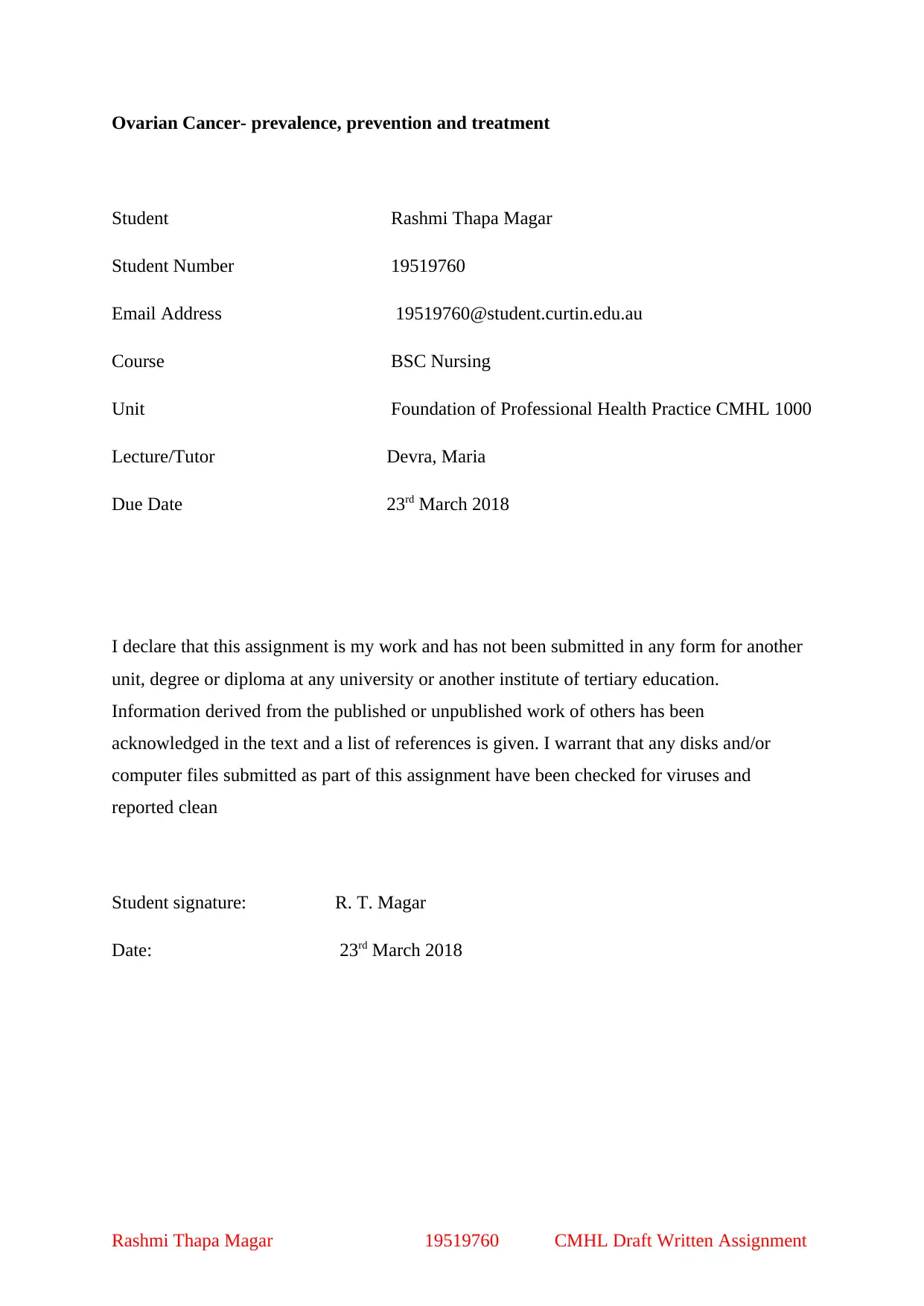
Ovarian Cancer- prevalence, prevention and treatment
Student Rashmi Thapa Magar
Student Number 19519760
Email Address 19519760@student.curtin.edu.au
Course BSC Nursing
Unit Foundation of Professional Health Practice CMHL 1000
Lecture/Tutor Devra, Maria
Due Date 23rd March 2018
I declare that this assignment is my work and has not been submitted in any form for another
unit, degree or diploma at any university or another institute of tertiary education.
Information derived from the published or unpublished work of others has been
acknowledged in the text and a list of references is given. I warrant that any disks and/or
computer files submitted as part of this assignment have been checked for viruses and
reported clean
Student signature: R. T. Magar
Date: 23rd March 2018
Rashmi Thapa Magar 19519760 CMHL Draft Written Assignment
Student Rashmi Thapa Magar
Student Number 19519760
Email Address 19519760@student.curtin.edu.au
Course BSC Nursing
Unit Foundation of Professional Health Practice CMHL 1000
Lecture/Tutor Devra, Maria
Due Date 23rd March 2018
I declare that this assignment is my work and has not been submitted in any form for another
unit, degree or diploma at any university or another institute of tertiary education.
Information derived from the published or unpublished work of others has been
acknowledged in the text and a list of references is given. I warrant that any disks and/or
computer files submitted as part of this assignment have been checked for viruses and
reported clean
Student signature: R. T. Magar
Date: 23rd March 2018
Rashmi Thapa Magar 19519760 CMHL Draft Written Assignment
Secure Best Marks with AI Grader
Need help grading? Try our AI Grader for instant feedback on your assignments.
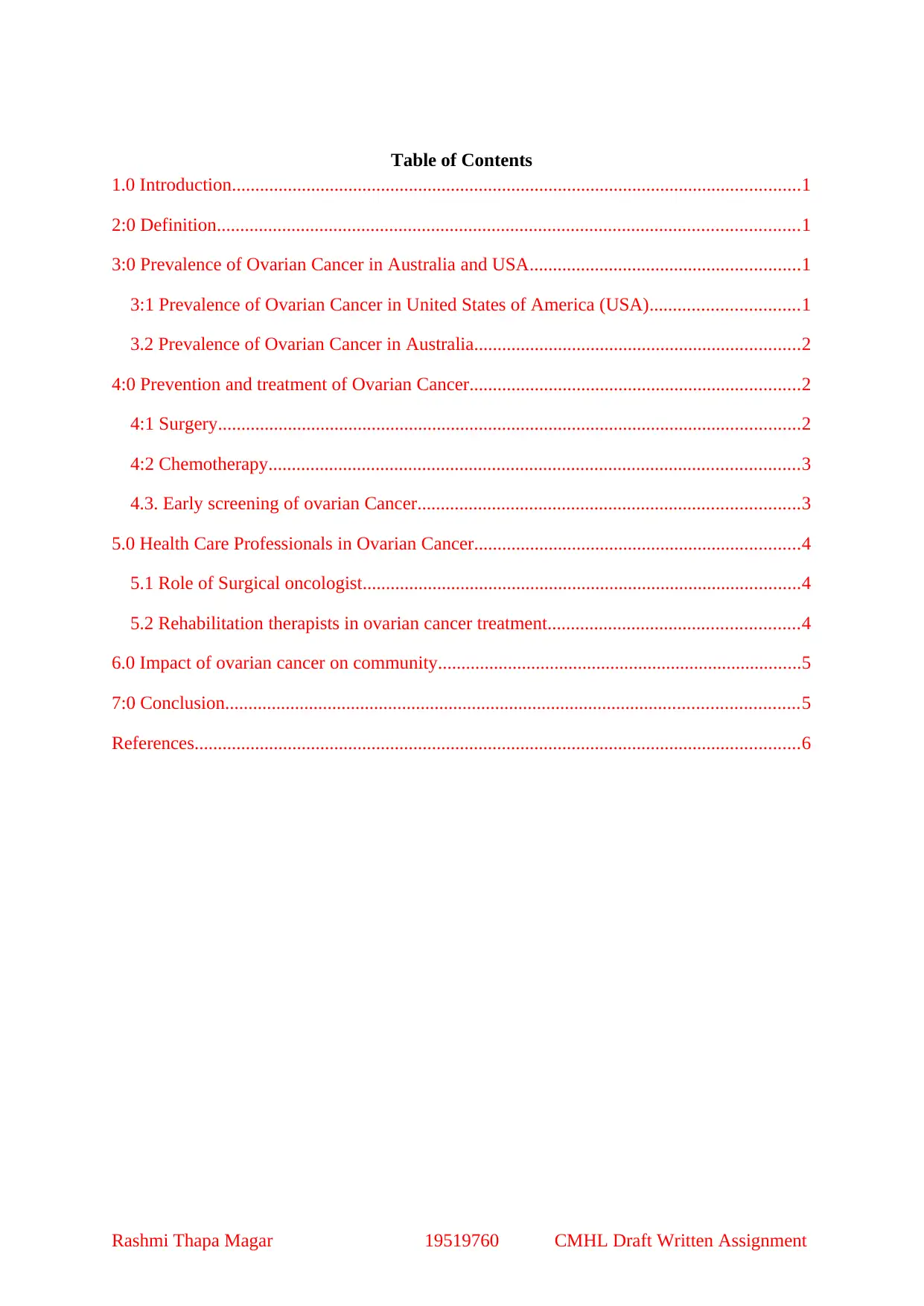
Table of Contents
1.0 Introduction..........................................................................................................................1
2:0 Definition.............................................................................................................................1
3:0 Prevalence of Ovarian Cancer in Australia and USA..........................................................1
3:1 Prevalence of Ovarian Cancer in United States of America (USA)................................1
3.2 Prevalence of Ovarian Cancer in Australia......................................................................2
4:0 Prevention and treatment of Ovarian Cancer.......................................................................2
4:1 Surgery.............................................................................................................................2
4:2 Chemotherapy..................................................................................................................3
4.3. Early screening of ovarian Cancer..................................................................................3
5.0 Health Care Professionals in Ovarian Cancer......................................................................4
5.1 Role of Surgical oncologist..............................................................................................4
5.2 Rehabilitation therapists in ovarian cancer treatment......................................................4
6.0 Impact of ovarian cancer on community..............................................................................5
7:0 Conclusion...........................................................................................................................5
References..................................................................................................................................6
Rashmi Thapa Magar 19519760 CMHL Draft Written Assignment
1.0 Introduction..........................................................................................................................1
2:0 Definition.............................................................................................................................1
3:0 Prevalence of Ovarian Cancer in Australia and USA..........................................................1
3:1 Prevalence of Ovarian Cancer in United States of America (USA)................................1
3.2 Prevalence of Ovarian Cancer in Australia......................................................................2
4:0 Prevention and treatment of Ovarian Cancer.......................................................................2
4:1 Surgery.............................................................................................................................2
4:2 Chemotherapy..................................................................................................................3
4.3. Early screening of ovarian Cancer..................................................................................3
5.0 Health Care Professionals in Ovarian Cancer......................................................................4
5.1 Role of Surgical oncologist..............................................................................................4
5.2 Rehabilitation therapists in ovarian cancer treatment......................................................4
6.0 Impact of ovarian cancer on community..............................................................................5
7:0 Conclusion...........................................................................................................................5
References..................................................................................................................................6
Rashmi Thapa Magar 19519760 CMHL Draft Written Assignment

1
1.0 Introduction
The main aim of this article is to reflect on ovarian cancer, its prevalence or incidence in
Australia and USA. It also provides the treatment and prevention of ovarian cancer. Webb,
Green, and Jordan (2017) suggested that ovarian cancer was listed seventh most common
cancer in women globally with 240,000 new cases in 2012.
2:0 Definition
Ovarian cancer is a life-threating disease, with only 30%of cure rate (Lengyel, 2010).
Ovarian Cancer arises when atypical cells in a fallopian tube, an ovary in an uncontrolled
way. These ovaries are in pair found in the uterus of the female reproductive system (Cancer
Australia, 2018). There are three possible sites of ovarian cancer originations: the fallopian
tube, the surfaces of the ovary, or the mesothelium-lined peritoneal cavity (Lengyel, 2010).
Older age, family background of ovarian cancer, use of oral contraceptive pills and smoking
are some important risk factors for ovarian cancer (Jones et al., 2010. Morch, Lokkegard,
Andreasen, Kruger-Kjearr, and Lidegaard (2009) concluded that combined hormone therapy
(types of regimes, routes of administration, progestin types, doses amount, and length of use)
and estrogen therapy have increased the risk of ovarian cancer. Abdominal bloating,
mysterious weight gain or weight loss, changes in bowel system, changes in the monthly
cycle, tiredness, backache are the main symptoms of ovarian cancer (Jones et al., 2010).
3:0 Prevalence of Ovarian Cancer in Australia and USA
3:1 Prevalence of Ovarian Cancer in United States of America (USA)
The research conducted by American Cancer Society stated that 21,550 new cases of
epithelial ovarian cancer and 14,600 deaths related to ovarian cancer in 2009 (Lengyel,
2010). The overall rate was 16.2 per 100,000 and the medium age of ovarian cancer was 60 in
USA (Arab et al., 2010). Arab et al. (2010) concluded that life expectancy is higher in USA
so the medium age for ovarian cancer in USA is higher than other parts of world. “The 5-year
survival rate for patients with ovarian cancer is only 35%” (Su et al., 2012, p. 1).
1.0 Introduction
The main aim of this article is to reflect on ovarian cancer, its prevalence or incidence in
Australia and USA. It also provides the treatment and prevention of ovarian cancer. Webb,
Green, and Jordan (2017) suggested that ovarian cancer was listed seventh most common
cancer in women globally with 240,000 new cases in 2012.
2:0 Definition
Ovarian cancer is a life-threating disease, with only 30%of cure rate (Lengyel, 2010).
Ovarian Cancer arises when atypical cells in a fallopian tube, an ovary in an uncontrolled
way. These ovaries are in pair found in the uterus of the female reproductive system (Cancer
Australia, 2018). There are three possible sites of ovarian cancer originations: the fallopian
tube, the surfaces of the ovary, or the mesothelium-lined peritoneal cavity (Lengyel, 2010).
Older age, family background of ovarian cancer, use of oral contraceptive pills and smoking
are some important risk factors for ovarian cancer (Jones et al., 2010. Morch, Lokkegard,
Andreasen, Kruger-Kjearr, and Lidegaard (2009) concluded that combined hormone therapy
(types of regimes, routes of administration, progestin types, doses amount, and length of use)
and estrogen therapy have increased the risk of ovarian cancer. Abdominal bloating,
mysterious weight gain or weight loss, changes in bowel system, changes in the monthly
cycle, tiredness, backache are the main symptoms of ovarian cancer (Jones et al., 2010).
3:0 Prevalence of Ovarian Cancer in Australia and USA
3:1 Prevalence of Ovarian Cancer in United States of America (USA)
The research conducted by American Cancer Society stated that 21,550 new cases of
epithelial ovarian cancer and 14,600 deaths related to ovarian cancer in 2009 (Lengyel,
2010). The overall rate was 16.2 per 100,000 and the medium age of ovarian cancer was 60 in
USA (Arab et al., 2010). Arab et al. (2010) concluded that life expectancy is higher in USA
so the medium age for ovarian cancer in USA is higher than other parts of world. “The 5-year
survival rate for patients with ovarian cancer is only 35%” (Su et al., 2012, p. 1).
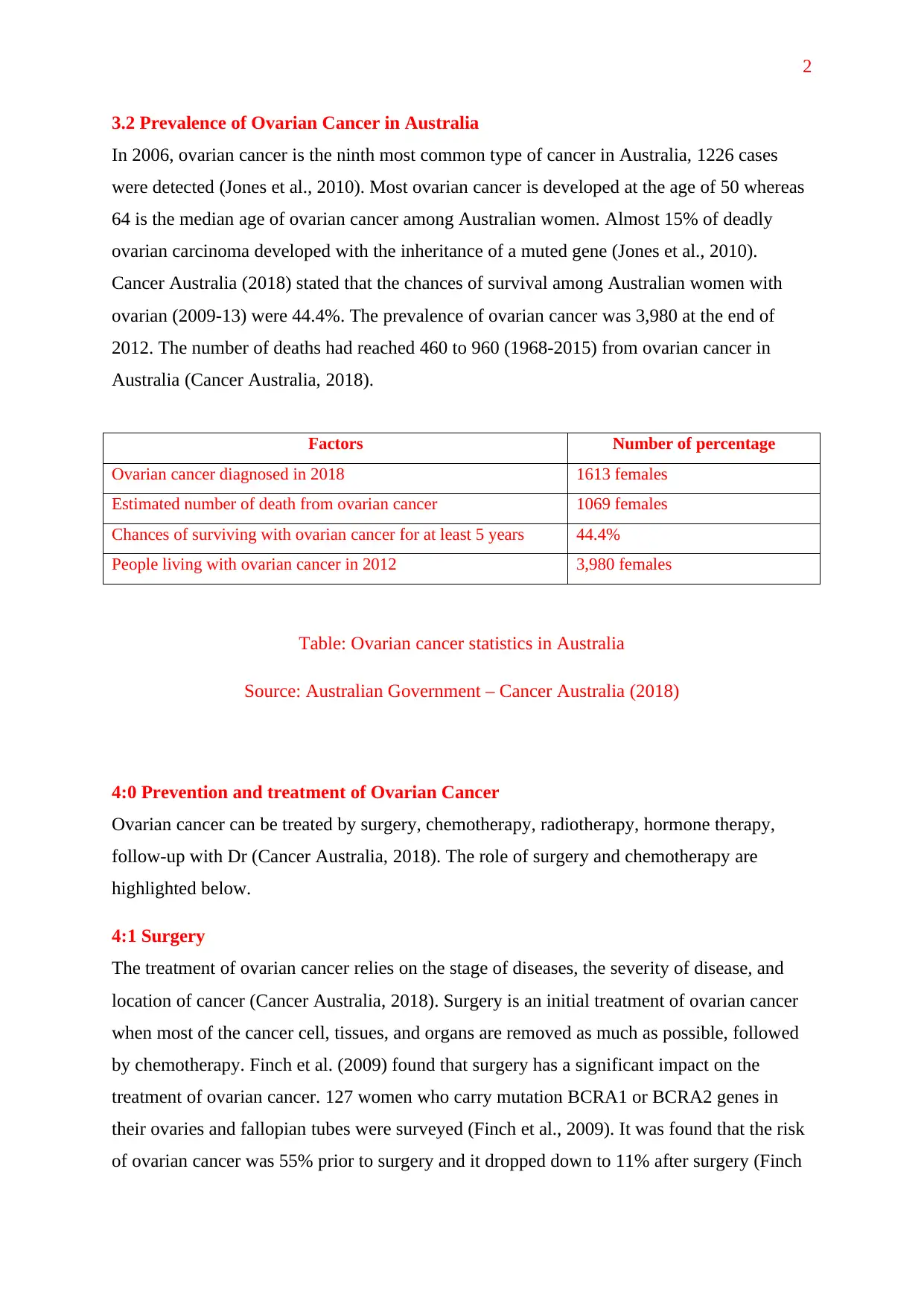
2
3.2 Prevalence of Ovarian Cancer in Australia
In 2006, ovarian cancer is the ninth most common type of cancer in Australia, 1226 cases
were detected (Jones et al., 2010). Most ovarian cancer is developed at the age of 50 whereas
64 is the median age of ovarian cancer among Australian women. Almost 15% of deadly
ovarian carcinoma developed with the inheritance of a muted gene (Jones et al., 2010).
Cancer Australia (2018) stated that the chances of survival among Australian women with
ovarian (2009-13) were 44.4%. The prevalence of ovarian cancer was 3,980 at the end of
2012. The number of deaths had reached 460 to 960 (1968-2015) from ovarian cancer in
Australia (Cancer Australia, 2018).
Factors Number of percentage
Ovarian cancer diagnosed in 2018 1613 females
Estimated number of death from ovarian cancer 1069 females
Chances of surviving with ovarian cancer for at least 5 years 44.4%
People living with ovarian cancer in 2012 3,980 females
Table: Ovarian cancer statistics in Australia
Source: Australian Government – Cancer Australia (2018)
4:0 Prevention and treatment of Ovarian Cancer
Ovarian cancer can be treated by surgery, chemotherapy, radiotherapy, hormone therapy,
follow-up with Dr (Cancer Australia, 2018). The role of surgery and chemotherapy are
highlighted below.
4:1 Surgery
The treatment of ovarian cancer relies on the stage of diseases, the severity of disease, and
location of cancer (Cancer Australia, 2018). Surgery is an initial treatment of ovarian cancer
when most of the cancer cell, tissues, and organs are removed as much as possible, followed
by chemotherapy. Finch et al. (2009) found that surgery has a significant impact on the
treatment of ovarian cancer. 127 women who carry mutation BCRA1 or BCRA2 genes in
their ovaries and fallopian tubes were surveyed (Finch et al., 2009). It was found that the risk
of ovarian cancer was 55% prior to surgery and it dropped down to 11% after surgery (Finch
3.2 Prevalence of Ovarian Cancer in Australia
In 2006, ovarian cancer is the ninth most common type of cancer in Australia, 1226 cases
were detected (Jones et al., 2010). Most ovarian cancer is developed at the age of 50 whereas
64 is the median age of ovarian cancer among Australian women. Almost 15% of deadly
ovarian carcinoma developed with the inheritance of a muted gene (Jones et al., 2010).
Cancer Australia (2018) stated that the chances of survival among Australian women with
ovarian (2009-13) were 44.4%. The prevalence of ovarian cancer was 3,980 at the end of
2012. The number of deaths had reached 460 to 960 (1968-2015) from ovarian cancer in
Australia (Cancer Australia, 2018).
Factors Number of percentage
Ovarian cancer diagnosed in 2018 1613 females
Estimated number of death from ovarian cancer 1069 females
Chances of surviving with ovarian cancer for at least 5 years 44.4%
People living with ovarian cancer in 2012 3,980 females
Table: Ovarian cancer statistics in Australia
Source: Australian Government – Cancer Australia (2018)
4:0 Prevention and treatment of Ovarian Cancer
Ovarian cancer can be treated by surgery, chemotherapy, radiotherapy, hormone therapy,
follow-up with Dr (Cancer Australia, 2018). The role of surgery and chemotherapy are
highlighted below.
4:1 Surgery
The treatment of ovarian cancer relies on the stage of diseases, the severity of disease, and
location of cancer (Cancer Australia, 2018). Surgery is an initial treatment of ovarian cancer
when most of the cancer cell, tissues, and organs are removed as much as possible, followed
by chemotherapy. Finch et al. (2009) found that surgery has a significant impact on the
treatment of ovarian cancer. 127 women who carry mutation BCRA1 or BCRA2 genes in
their ovaries and fallopian tubes were surveyed (Finch et al., 2009). It was found that the risk
of ovarian cancer was 55% prior to surgery and it dropped down to 11% after surgery (Finch
Secure Best Marks with AI Grader
Need help grading? Try our AI Grader for instant feedback on your assignments.
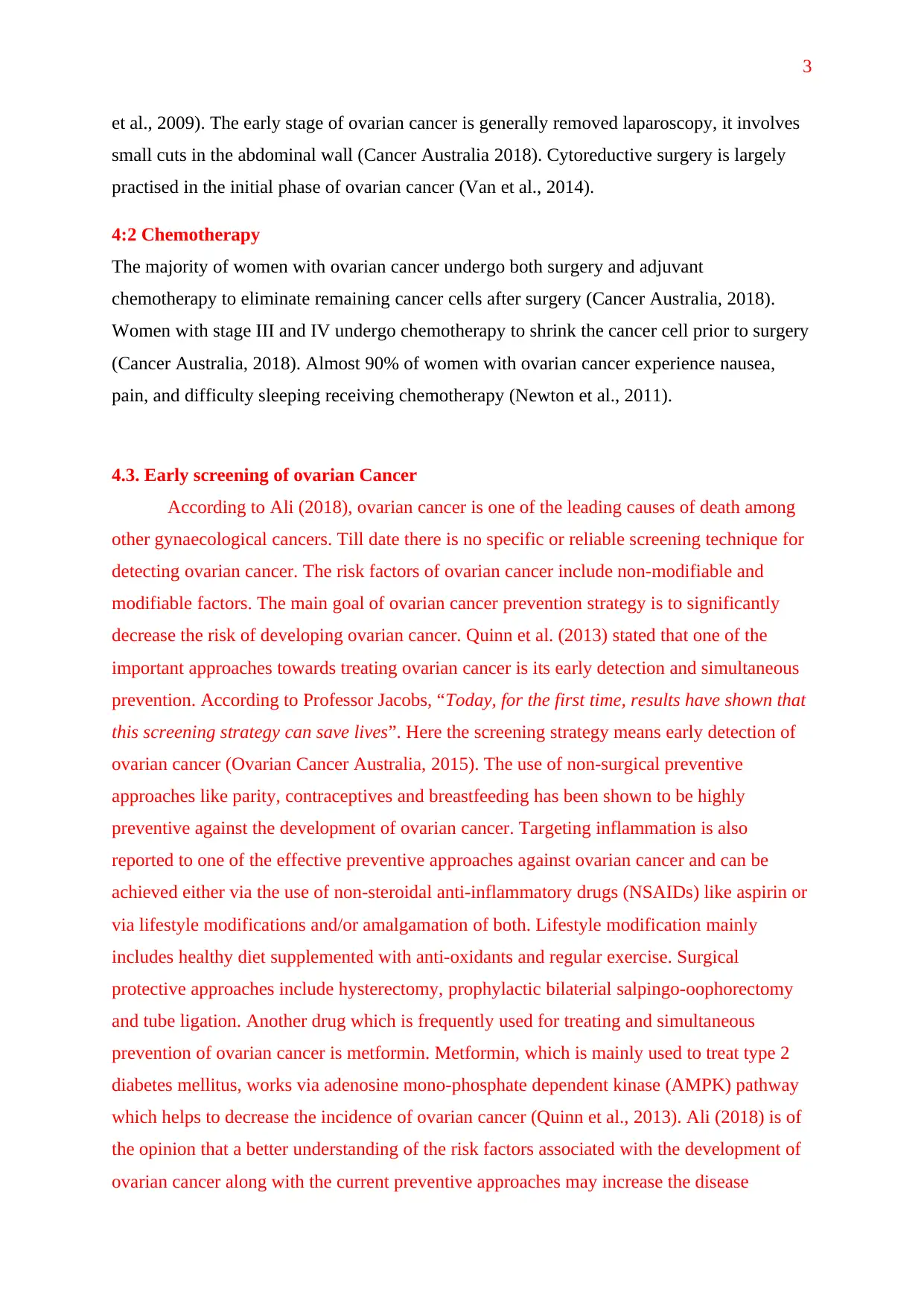
3
et al., 2009). The early stage of ovarian cancer is generally removed laparoscopy, it involves
small cuts in the abdominal wall (Cancer Australia 2018). Cytoreductive surgery is largely
practised in the initial phase of ovarian cancer (Van et al., 2014).
4:2 Chemotherapy
The majority of women with ovarian cancer undergo both surgery and adjuvant
chemotherapy to eliminate remaining cancer cells after surgery (Cancer Australia, 2018).
Women with stage III and IV undergo chemotherapy to shrink the cancer cell prior to surgery
(Cancer Australia, 2018). Almost 90% of women with ovarian cancer experience nausea,
pain, and difficulty sleeping receiving chemotherapy (Newton et al., 2011).
4.3. Early screening of ovarian Cancer
According to Ali (2018), ovarian cancer is one of the leading causes of death among
other gynaecological cancers. Till date there is no specific or reliable screening technique for
detecting ovarian cancer. The risk factors of ovarian cancer include non-modifiable and
modifiable factors. The main goal of ovarian cancer prevention strategy is to significantly
decrease the risk of developing ovarian cancer. Quinn et al. (2013) stated that one of the
important approaches towards treating ovarian cancer is its early detection and simultaneous
prevention. According to Professor Jacobs, “Today, for the first time, results have shown that
this screening strategy can save lives”. Here the screening strategy means early detection of
ovarian cancer (Ovarian Cancer Australia, 2015). The use of non-surgical preventive
approaches like parity, contraceptives and breastfeeding has been shown to be highly
preventive against the development of ovarian cancer. Targeting inflammation is also
reported to one of the effective preventive approaches against ovarian cancer and can be
achieved either via the use of non-steroidal anti-inflammatory drugs (NSAIDs) like aspirin or
via lifestyle modifications and/or amalgamation of both. Lifestyle modification mainly
includes healthy diet supplemented with anti-oxidants and regular exercise. Surgical
protective approaches include hysterectomy, prophylactic bilaterial salpingo-oophorectomy
and tube ligation. Another drug which is frequently used for treating and simultaneous
prevention of ovarian cancer is metformin. Metformin, which is mainly used to treat type 2
diabetes mellitus, works via adenosine mono-phosphate dependent kinase (AMPK) pathway
which helps to decrease the incidence of ovarian cancer (Quinn et al., 2013). Ali (2018) is of
the opinion that a better understanding of the risk factors associated with the development of
ovarian cancer along with the current preventive approaches may increase the disease
et al., 2009). The early stage of ovarian cancer is generally removed laparoscopy, it involves
small cuts in the abdominal wall (Cancer Australia 2018). Cytoreductive surgery is largely
practised in the initial phase of ovarian cancer (Van et al., 2014).
4:2 Chemotherapy
The majority of women with ovarian cancer undergo both surgery and adjuvant
chemotherapy to eliminate remaining cancer cells after surgery (Cancer Australia, 2018).
Women with stage III and IV undergo chemotherapy to shrink the cancer cell prior to surgery
(Cancer Australia, 2018). Almost 90% of women with ovarian cancer experience nausea,
pain, and difficulty sleeping receiving chemotherapy (Newton et al., 2011).
4.3. Early screening of ovarian Cancer
According to Ali (2018), ovarian cancer is one of the leading causes of death among
other gynaecological cancers. Till date there is no specific or reliable screening technique for
detecting ovarian cancer. The risk factors of ovarian cancer include non-modifiable and
modifiable factors. The main goal of ovarian cancer prevention strategy is to significantly
decrease the risk of developing ovarian cancer. Quinn et al. (2013) stated that one of the
important approaches towards treating ovarian cancer is its early detection and simultaneous
prevention. According to Professor Jacobs, “Today, for the first time, results have shown that
this screening strategy can save lives”. Here the screening strategy means early detection of
ovarian cancer (Ovarian Cancer Australia, 2015). The use of non-surgical preventive
approaches like parity, contraceptives and breastfeeding has been shown to be highly
preventive against the development of ovarian cancer. Targeting inflammation is also
reported to one of the effective preventive approaches against ovarian cancer and can be
achieved either via the use of non-steroidal anti-inflammatory drugs (NSAIDs) like aspirin or
via lifestyle modifications and/or amalgamation of both. Lifestyle modification mainly
includes healthy diet supplemented with anti-oxidants and regular exercise. Surgical
protective approaches include hysterectomy, prophylactic bilaterial salpingo-oophorectomy
and tube ligation. Another drug which is frequently used for treating and simultaneous
prevention of ovarian cancer is metformin. Metformin, which is mainly used to treat type 2
diabetes mellitus, works via adenosine mono-phosphate dependent kinase (AMPK) pathway
which helps to decrease the incidence of ovarian cancer (Quinn et al., 2013). Ali (2018) is of
the opinion that a better understanding of the risk factors associated with the development of
ovarian cancer along with the current preventive approaches may increase the disease
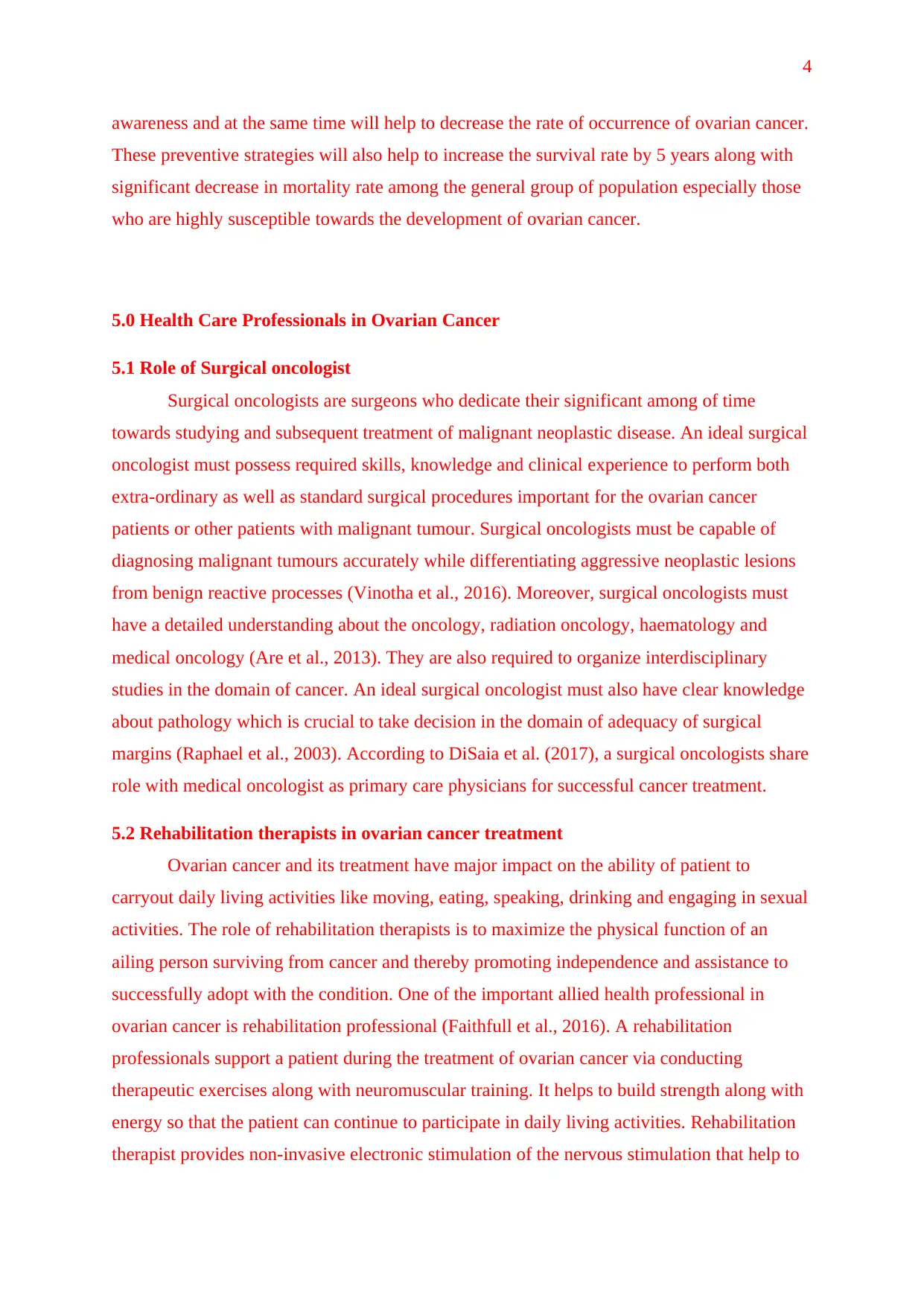
4
awareness and at the same time will help to decrease the rate of occurrence of ovarian cancer.
These preventive strategies will also help to increase the survival rate by 5 years along with
significant decrease in mortality rate among the general group of population especially those
who are highly susceptible towards the development of ovarian cancer.
5.0 Health Care Professionals in Ovarian Cancer
5.1 Role of Surgical oncologist
Surgical oncologists are surgeons who dedicate their significant among of time
towards studying and subsequent treatment of malignant neoplastic disease. An ideal surgical
oncologist must possess required skills, knowledge and clinical experience to perform both
extra-ordinary as well as standard surgical procedures important for the ovarian cancer
patients or other patients with malignant tumour. Surgical oncologists must be capable of
diagnosing malignant tumours accurately while differentiating aggressive neoplastic lesions
from benign reactive processes (Vinotha et al., 2016). Moreover, surgical oncologists must
have a detailed understanding about the oncology, radiation oncology, haematology and
medical oncology (Are et al., 2013). They are also required to organize interdisciplinary
studies in the domain of cancer. An ideal surgical oncologist must also have clear knowledge
about pathology which is crucial to take decision in the domain of adequacy of surgical
margins (Raphael et al., 2003). According to DiSaia et al. (2017), a surgical oncologists share
role with medical oncologist as primary care physicians for successful cancer treatment.
5.2 Rehabilitation therapists in ovarian cancer treatment
Ovarian cancer and its treatment have major impact on the ability of patient to
carryout daily living activities like moving, eating, speaking, drinking and engaging in sexual
activities. The role of rehabilitation therapists is to maximize the physical function of an
ailing person surviving from cancer and thereby promoting independence and assistance to
successfully adopt with the condition. One of the important allied health professional in
ovarian cancer is rehabilitation professional (Faithfull et al., 2016). A rehabilitation
professionals support a patient during the treatment of ovarian cancer via conducting
therapeutic exercises along with neuromuscular training. It helps to build strength along with
energy so that the patient can continue to participate in daily living activities. Rehabilitation
therapist provides non-invasive electronic stimulation of the nervous stimulation that help to
awareness and at the same time will help to decrease the rate of occurrence of ovarian cancer.
These preventive strategies will also help to increase the survival rate by 5 years along with
significant decrease in mortality rate among the general group of population especially those
who are highly susceptible towards the development of ovarian cancer.
5.0 Health Care Professionals in Ovarian Cancer
5.1 Role of Surgical oncologist
Surgical oncologists are surgeons who dedicate their significant among of time
towards studying and subsequent treatment of malignant neoplastic disease. An ideal surgical
oncologist must possess required skills, knowledge and clinical experience to perform both
extra-ordinary as well as standard surgical procedures important for the ovarian cancer
patients or other patients with malignant tumour. Surgical oncologists must be capable of
diagnosing malignant tumours accurately while differentiating aggressive neoplastic lesions
from benign reactive processes (Vinotha et al., 2016). Moreover, surgical oncologists must
have a detailed understanding about the oncology, radiation oncology, haematology and
medical oncology (Are et al., 2013). They are also required to organize interdisciplinary
studies in the domain of cancer. An ideal surgical oncologist must also have clear knowledge
about pathology which is crucial to take decision in the domain of adequacy of surgical
margins (Raphael et al., 2003). According to DiSaia et al. (2017), a surgical oncologists share
role with medical oncologist as primary care physicians for successful cancer treatment.
5.2 Rehabilitation therapists in ovarian cancer treatment
Ovarian cancer and its treatment have major impact on the ability of patient to
carryout daily living activities like moving, eating, speaking, drinking and engaging in sexual
activities. The role of rehabilitation therapists is to maximize the physical function of an
ailing person surviving from cancer and thereby promoting independence and assistance to
successfully adopt with the condition. One of the important allied health professional in
ovarian cancer is rehabilitation professional (Faithfull et al., 2016). A rehabilitation
professionals support a patient during the treatment of ovarian cancer via conducting
therapeutic exercises along with neuromuscular training. It helps to build strength along with
energy so that the patient can continue to participate in daily living activities. Rehabilitation
therapist provides non-invasive electronic stimulation of the nervous stimulation that help to
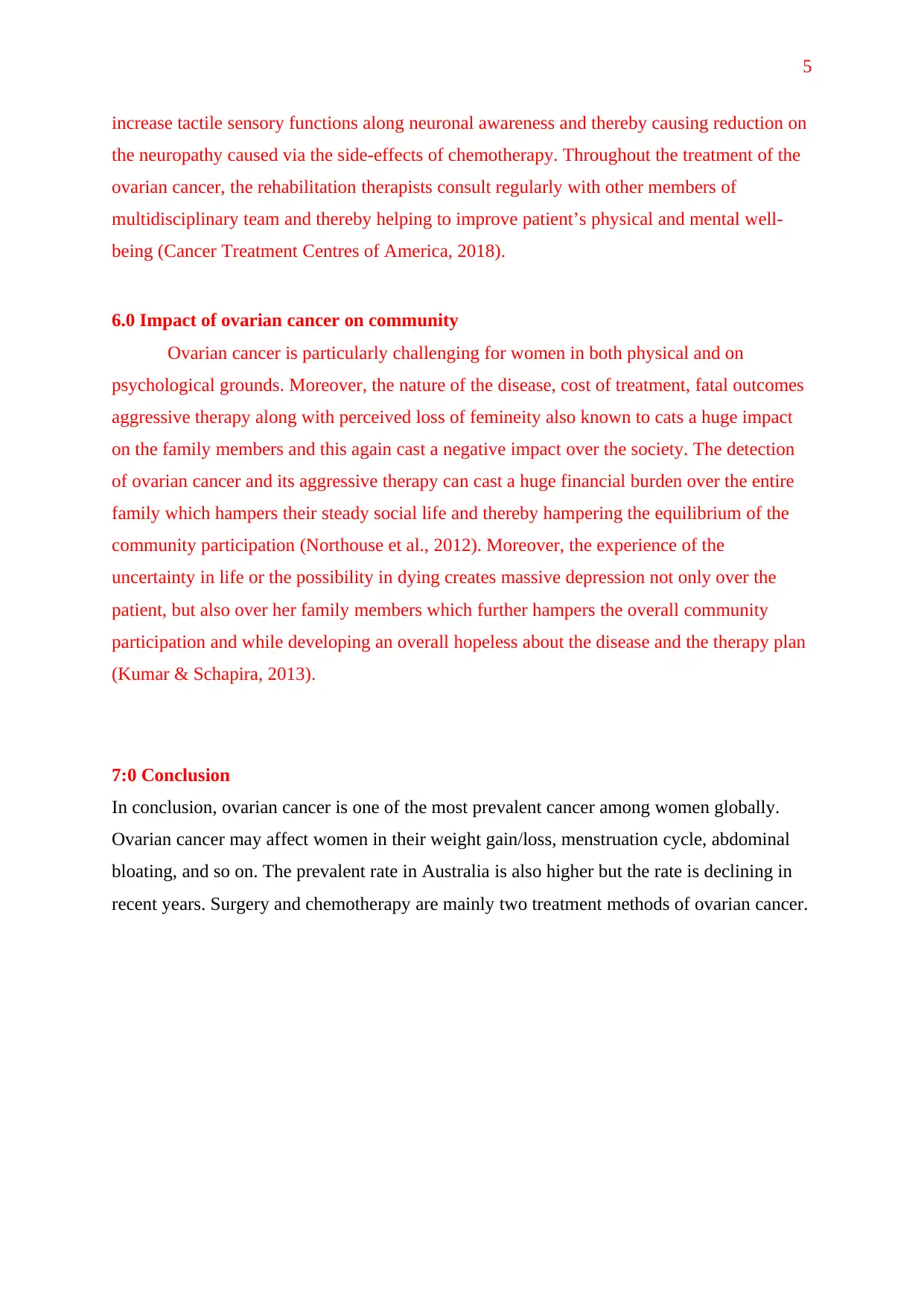
5
increase tactile sensory functions along neuronal awareness and thereby causing reduction on
the neuropathy caused via the side-effects of chemotherapy. Throughout the treatment of the
ovarian cancer, the rehabilitation therapists consult regularly with other members of
multidisciplinary team and thereby helping to improve patient’s physical and mental well-
being (Cancer Treatment Centres of America, 2018).
6.0 Impact of ovarian cancer on community
Ovarian cancer is particularly challenging for women in both physical and on
psychological grounds. Moreover, the nature of the disease, cost of treatment, fatal outcomes
aggressive therapy along with perceived loss of femineity also known to cats a huge impact
on the family members and this again cast a negative impact over the society. The detection
of ovarian cancer and its aggressive therapy can cast a huge financial burden over the entire
family which hampers their steady social life and thereby hampering the equilibrium of the
community participation (Northouse et al., 2012). Moreover, the experience of the
uncertainty in life or the possibility in dying creates massive depression not only over the
patient, but also over her family members which further hampers the overall community
participation and while developing an overall hopeless about the disease and the therapy plan
(Kumar & Schapira, 2013).
7:0 Conclusion
In conclusion, ovarian cancer is one of the most prevalent cancer among women globally.
Ovarian cancer may affect women in their weight gain/loss, menstruation cycle, abdominal
bloating, and so on. The prevalent rate in Australia is also higher but the rate is declining in
recent years. Surgery and chemotherapy are mainly two treatment methods of ovarian cancer.
increase tactile sensory functions along neuronal awareness and thereby causing reduction on
the neuropathy caused via the side-effects of chemotherapy. Throughout the treatment of the
ovarian cancer, the rehabilitation therapists consult regularly with other members of
multidisciplinary team and thereby helping to improve patient’s physical and mental well-
being (Cancer Treatment Centres of America, 2018).
6.0 Impact of ovarian cancer on community
Ovarian cancer is particularly challenging for women in both physical and on
psychological grounds. Moreover, the nature of the disease, cost of treatment, fatal outcomes
aggressive therapy along with perceived loss of femineity also known to cats a huge impact
on the family members and this again cast a negative impact over the society. The detection
of ovarian cancer and its aggressive therapy can cast a huge financial burden over the entire
family which hampers their steady social life and thereby hampering the equilibrium of the
community participation (Northouse et al., 2012). Moreover, the experience of the
uncertainty in life or the possibility in dying creates massive depression not only over the
patient, but also over her family members which further hampers the overall community
participation and while developing an overall hopeless about the disease and the therapy plan
(Kumar & Schapira, 2013).
7:0 Conclusion
In conclusion, ovarian cancer is one of the most prevalent cancer among women globally.
Ovarian cancer may affect women in their weight gain/loss, menstruation cycle, abdominal
bloating, and so on. The prevalent rate in Australia is also higher but the rate is declining in
recent years. Surgery and chemotherapy are mainly two treatment methods of ovarian cancer.
Paraphrase This Document
Need a fresh take? Get an instant paraphrase of this document with our AI Paraphraser
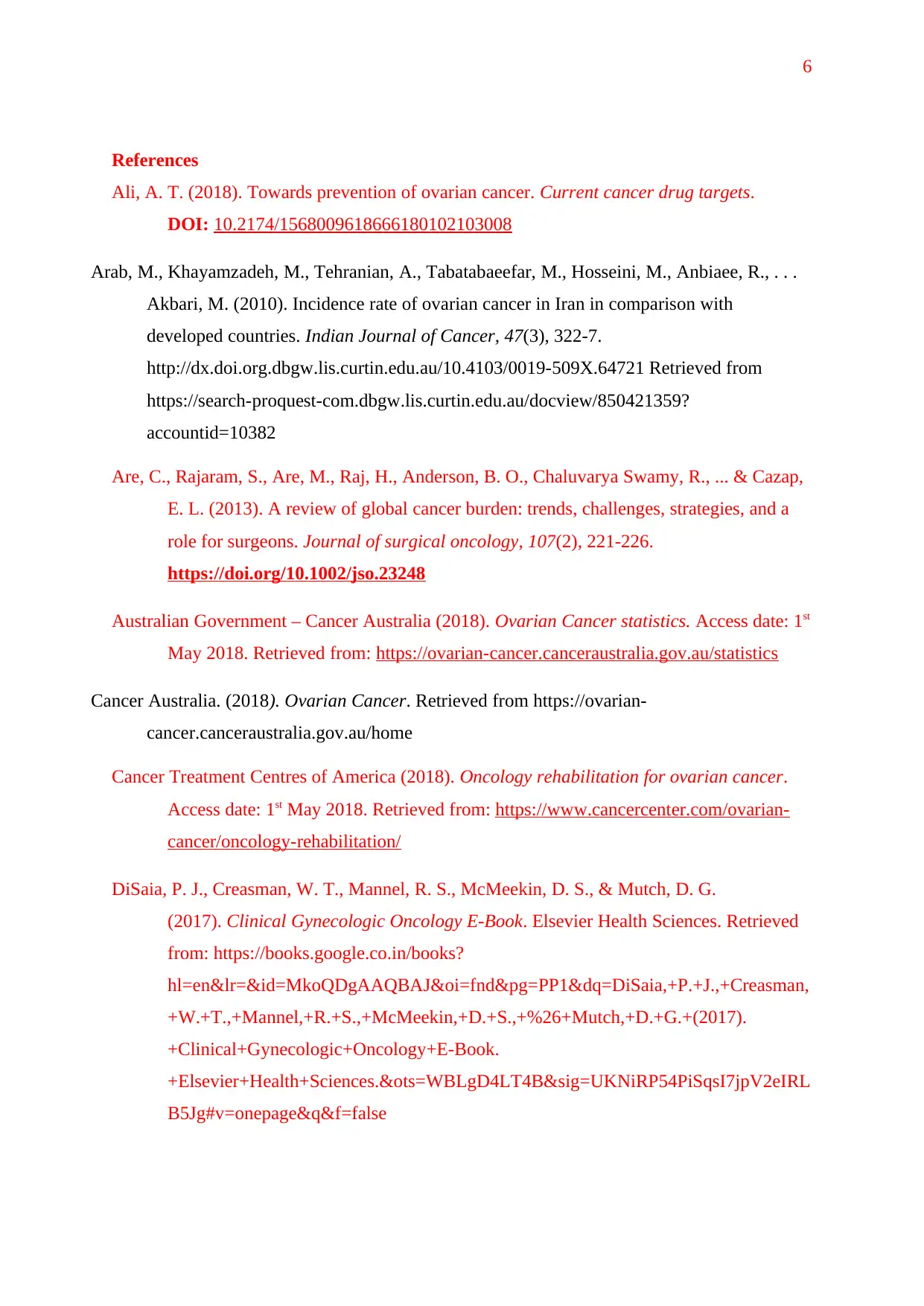
6
References
Ali, A. T. (2018). Towards prevention of ovarian cancer. Current cancer drug targets.
DOI: 10.2174/1568009618666180102103008
Arab, M., Khayamzadeh, M., Tehranian, A., Tabatabaeefar, M., Hosseini, M., Anbiaee, R., . . .
Akbari, M. (2010). Incidence rate of ovarian cancer in Iran in comparison with
developed countries. Indian Journal of Cancer, 47(3), 322-7.
http://dx.doi.org.dbgw.lis.curtin.edu.au/10.4103/0019-509X.64721 Retrieved from
https://search-proquest-com.dbgw.lis.curtin.edu.au/docview/850421359?
accountid=10382
Are, C., Rajaram, S., Are, M., Raj, H., Anderson, B. O., Chaluvarya Swamy, R., ... & Cazap,
E. L. (2013). A review of global cancer burden: trends, challenges, strategies, and a
role for surgeons. Journal of surgical oncology, 107(2), 221-226.
https://doi.org/10.1002/jso.23248
Australian Government – Cancer Australia (2018). Ovarian Cancer statistics. Access date: 1st
May 2018. Retrieved from: https://ovarian-cancer.canceraustralia.gov.au/statistics
Cancer Australia. (2018). Ovarian Cancer. Retrieved from https://ovarian-
cancer.canceraustralia.gov.au/home
Cancer Treatment Centres of America (2018). Oncology rehabilitation for ovarian cancer.
Access date: 1st May 2018. Retrieved from: https://www.cancercenter.com/ovarian-
cancer/oncology-rehabilitation/
DiSaia, P. J., Creasman, W. T., Mannel, R. S., McMeekin, D. S., & Mutch, D. G.
(2017). Clinical Gynecologic Oncology E-Book. Elsevier Health Sciences. Retrieved
from: https://books.google.co.in/books?
hl=en&lr=&id=MkoQDgAAQBAJ&oi=fnd&pg=PP1&dq=DiSaia,+P.+J.,+Creasman,
+W.+T.,+Mannel,+R.+S.,+McMeekin,+D.+S.,+%26+Mutch,+D.+G.+(2017).
+Clinical+Gynecologic+Oncology+E-Book.
+Elsevier+Health+Sciences.&ots=WBLgD4LT4B&sig=UKNiRP54PiSqsI7jpV2eIRL
B5Jg#v=onepage&q&f=false
References
Ali, A. T. (2018). Towards prevention of ovarian cancer. Current cancer drug targets.
DOI: 10.2174/1568009618666180102103008
Arab, M., Khayamzadeh, M., Tehranian, A., Tabatabaeefar, M., Hosseini, M., Anbiaee, R., . . .
Akbari, M. (2010). Incidence rate of ovarian cancer in Iran in comparison with
developed countries. Indian Journal of Cancer, 47(3), 322-7.
http://dx.doi.org.dbgw.lis.curtin.edu.au/10.4103/0019-509X.64721 Retrieved from
https://search-proquest-com.dbgw.lis.curtin.edu.au/docview/850421359?
accountid=10382
Are, C., Rajaram, S., Are, M., Raj, H., Anderson, B. O., Chaluvarya Swamy, R., ... & Cazap,
E. L. (2013). A review of global cancer burden: trends, challenges, strategies, and a
role for surgeons. Journal of surgical oncology, 107(2), 221-226.
https://doi.org/10.1002/jso.23248
Australian Government – Cancer Australia (2018). Ovarian Cancer statistics. Access date: 1st
May 2018. Retrieved from: https://ovarian-cancer.canceraustralia.gov.au/statistics
Cancer Australia. (2018). Ovarian Cancer. Retrieved from https://ovarian-
cancer.canceraustralia.gov.au/home
Cancer Treatment Centres of America (2018). Oncology rehabilitation for ovarian cancer.
Access date: 1st May 2018. Retrieved from: https://www.cancercenter.com/ovarian-
cancer/oncology-rehabilitation/
DiSaia, P. J., Creasman, W. T., Mannel, R. S., McMeekin, D. S., & Mutch, D. G.
(2017). Clinical Gynecologic Oncology E-Book. Elsevier Health Sciences. Retrieved
from: https://books.google.co.in/books?
hl=en&lr=&id=MkoQDgAAQBAJ&oi=fnd&pg=PP1&dq=DiSaia,+P.+J.,+Creasman,
+W.+T.,+Mannel,+R.+S.,+McMeekin,+D.+S.,+%26+Mutch,+D.+G.+(2017).
+Clinical+Gynecologic+Oncology+E-Book.
+Elsevier+Health+Sciences.&ots=WBLgD4LT4B&sig=UKNiRP54PiSqsI7jpV2eIRL
B5Jg#v=onepage&q&f=false
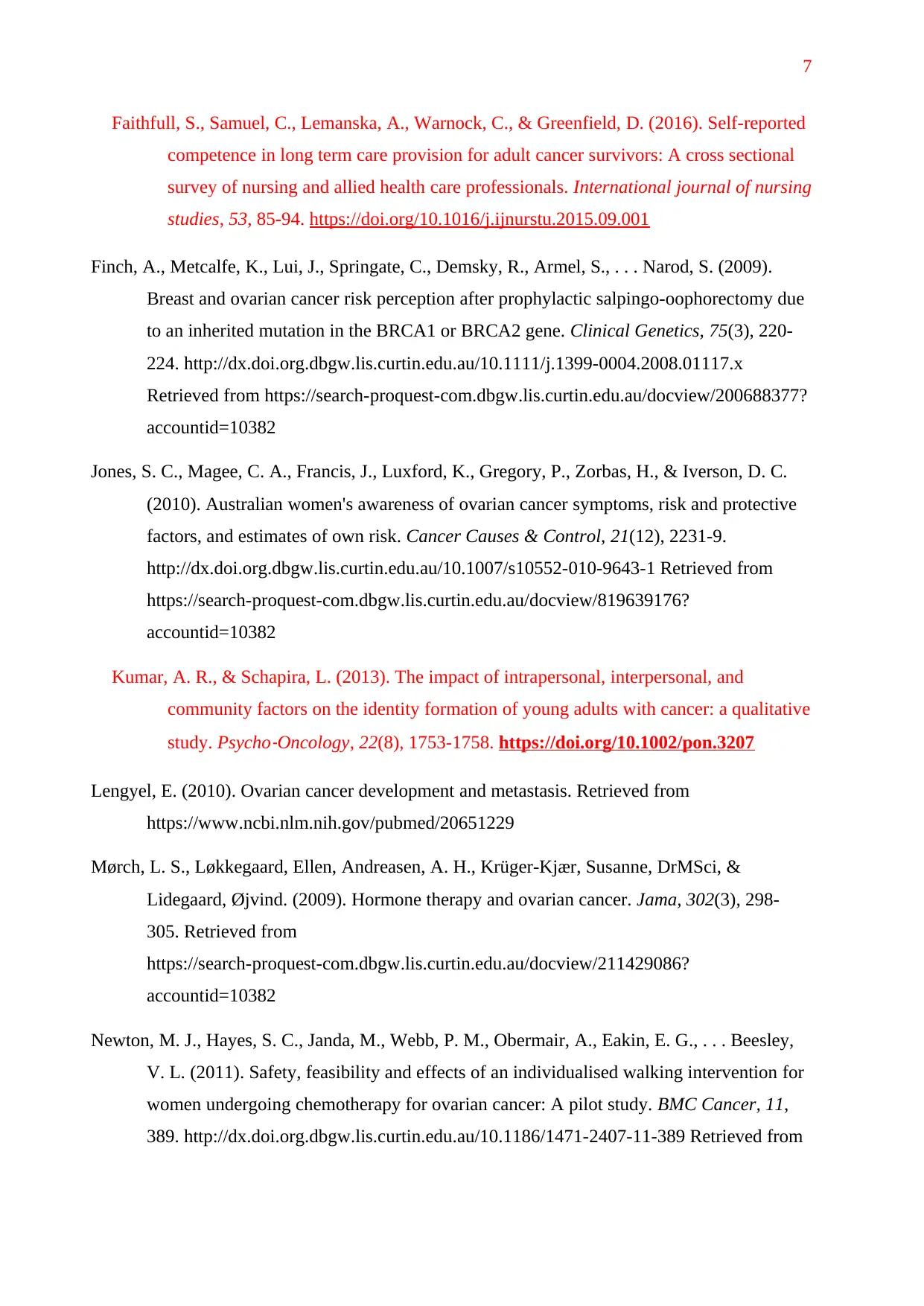
7
Faithfull, S., Samuel, C., Lemanska, A., Warnock, C., & Greenfield, D. (2016). Self-reported
competence in long term care provision for adult cancer survivors: A cross sectional
survey of nursing and allied health care professionals. International journal of nursing
studies, 53, 85-94. https://doi.org/10.1016/j.ijnurstu.2015.09.001
Finch, A., Metcalfe, K., Lui, J., Springate, C., Demsky, R., Armel, S., . . . Narod, S. (2009).
Breast and ovarian cancer risk perception after prophylactic salpingo-oophorectomy due
to an inherited mutation in the BRCA1 or BRCA2 gene. Clinical Genetics, 75(3), 220-
224. http://dx.doi.org.dbgw.lis.curtin.edu.au/10.1111/j.1399-0004.2008.01117.x
Retrieved from https://search-proquest-com.dbgw.lis.curtin.edu.au/docview/200688377?
accountid=10382
Jones, S. C., Magee, C. A., Francis, J., Luxford, K., Gregory, P., Zorbas, H., & Iverson, D. C.
(2010). Australian women's awareness of ovarian cancer symptoms, risk and protective
factors, and estimates of own risk. Cancer Causes & Control, 21(12), 2231-9.
http://dx.doi.org.dbgw.lis.curtin.edu.au/10.1007/s10552-010-9643-1 Retrieved from
https://search-proquest-com.dbgw.lis.curtin.edu.au/docview/819639176?
accountid=10382
Kumar, A. R., & Schapira, L. (2013). The impact of intrapersonal, interpersonal, and
community factors on the identity formation of young adults with cancer: a qualitative
study. Psycho
‐Oncology, 22(8), 1753-1758. https://doi.org/10.1002/pon.3207
Lengyel, E. (2010). Ovarian cancer development and metastasis. Retrieved from
https://www.ncbi.nlm.nih.gov/pubmed/20651229
Mørch, L. S., Løkkegaard, Ellen, Andreasen, A. H., Krüger-Kjær, Susanne, DrMSci, &
Lidegaard, Øjvind. (2009). Hormone therapy and ovarian cancer. Jama, 302(3), 298-
305. Retrieved from
https://search-proquest-com.dbgw.lis.curtin.edu.au/docview/211429086?
accountid=10382
Newton, M. J., Hayes, S. C., Janda, M., Webb, P. M., Obermair, A., Eakin, E. G., . . . Beesley,
V. L. (2011). Safety, feasibility and effects of an individualised walking intervention for
women undergoing chemotherapy for ovarian cancer: A pilot study. BMC Cancer, 11,
389. http://dx.doi.org.dbgw.lis.curtin.edu.au/10.1186/1471-2407-11-389 Retrieved from
Faithfull, S., Samuel, C., Lemanska, A., Warnock, C., & Greenfield, D. (2016). Self-reported
competence in long term care provision for adult cancer survivors: A cross sectional
survey of nursing and allied health care professionals. International journal of nursing
studies, 53, 85-94. https://doi.org/10.1016/j.ijnurstu.2015.09.001
Finch, A., Metcalfe, K., Lui, J., Springate, C., Demsky, R., Armel, S., . . . Narod, S. (2009).
Breast and ovarian cancer risk perception after prophylactic salpingo-oophorectomy due
to an inherited mutation in the BRCA1 or BRCA2 gene. Clinical Genetics, 75(3), 220-
224. http://dx.doi.org.dbgw.lis.curtin.edu.au/10.1111/j.1399-0004.2008.01117.x
Retrieved from https://search-proquest-com.dbgw.lis.curtin.edu.au/docview/200688377?
accountid=10382
Jones, S. C., Magee, C. A., Francis, J., Luxford, K., Gregory, P., Zorbas, H., & Iverson, D. C.
(2010). Australian women's awareness of ovarian cancer symptoms, risk and protective
factors, and estimates of own risk. Cancer Causes & Control, 21(12), 2231-9.
http://dx.doi.org.dbgw.lis.curtin.edu.au/10.1007/s10552-010-9643-1 Retrieved from
https://search-proquest-com.dbgw.lis.curtin.edu.au/docview/819639176?
accountid=10382
Kumar, A. R., & Schapira, L. (2013). The impact of intrapersonal, interpersonal, and
community factors on the identity formation of young adults with cancer: a qualitative
study. Psycho
‐Oncology, 22(8), 1753-1758. https://doi.org/10.1002/pon.3207
Lengyel, E. (2010). Ovarian cancer development and metastasis. Retrieved from
https://www.ncbi.nlm.nih.gov/pubmed/20651229
Mørch, L. S., Løkkegaard, Ellen, Andreasen, A. H., Krüger-Kjær, Susanne, DrMSci, &
Lidegaard, Øjvind. (2009). Hormone therapy and ovarian cancer. Jama, 302(3), 298-
305. Retrieved from
https://search-proquest-com.dbgw.lis.curtin.edu.au/docview/211429086?
accountid=10382
Newton, M. J., Hayes, S. C., Janda, M., Webb, P. M., Obermair, A., Eakin, E. G., . . . Beesley,
V. L. (2011). Safety, feasibility and effects of an individualised walking intervention for
women undergoing chemotherapy for ovarian cancer: A pilot study. BMC Cancer, 11,
389. http://dx.doi.org.dbgw.lis.curtin.edu.au/10.1186/1471-2407-11-389 Retrieved from
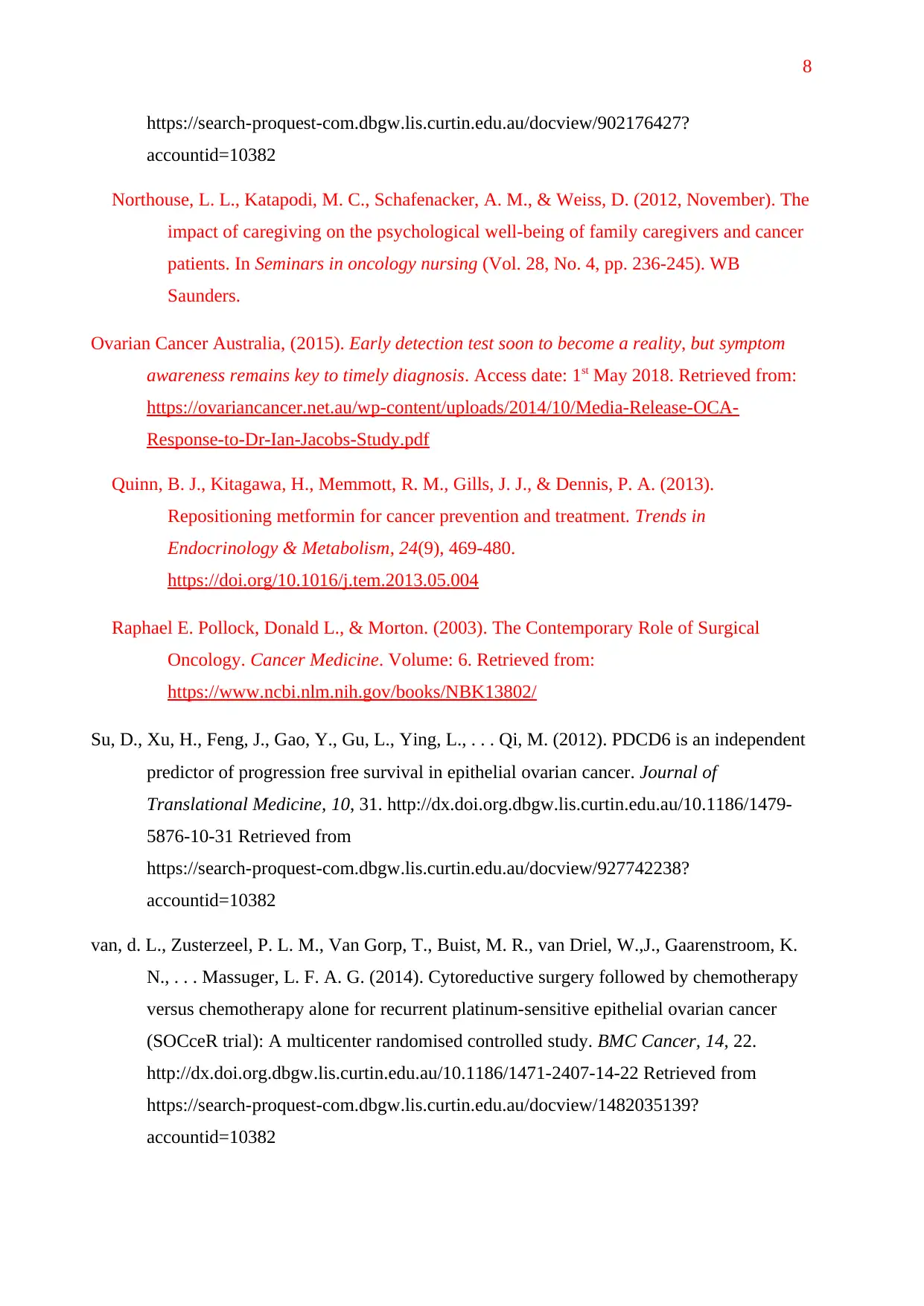
8
https://search-proquest-com.dbgw.lis.curtin.edu.au/docview/902176427?
accountid=10382
Northouse, L. L., Katapodi, M. C., Schafenacker, A. M., & Weiss, D. (2012, November). The
impact of caregiving on the psychological well-being of family caregivers and cancer
patients. In Seminars in oncology nursing (Vol. 28, No. 4, pp. 236-245). WB
Saunders.
Ovarian Cancer Australia, (2015). Early detection test soon to become a reality, but symptom
awareness remains key to timely diagnosis. Access date: 1st May 2018. Retrieved from:
https://ovariancancer.net.au/wp-content/uploads/2014/10/Media-Release-OCA-
Response-to-Dr-Ian-Jacobs-Study.pdf
Quinn, B. J., Kitagawa, H., Memmott, R. M., Gills, J. J., & Dennis, P. A. (2013).
Repositioning metformin for cancer prevention and treatment. Trends in
Endocrinology & Metabolism, 24(9), 469-480.
https://doi.org/10.1016/j.tem.2013.05.004
Raphael E. Pollock, Donald L., & Morton. (2003). The Contemporary Role of Surgical
Oncology. Cancer Medicine. Volume: 6. Retrieved from:
https://www.ncbi.nlm.nih.gov/books/NBK13802/
Su, D., Xu, H., Feng, J., Gao, Y., Gu, L., Ying, L., . . . Qi, M. (2012). PDCD6 is an independent
predictor of progression free survival in epithelial ovarian cancer. Journal of
Translational Medicine, 10, 31. http://dx.doi.org.dbgw.lis.curtin.edu.au/10.1186/1479-
5876-10-31 Retrieved from
https://search-proquest-com.dbgw.lis.curtin.edu.au/docview/927742238?
accountid=10382
van, d. L., Zusterzeel, P. L. M., Van Gorp, T., Buist, M. R., van Driel, W.,J., Gaarenstroom, K.
N., . . . Massuger, L. F. A. G. (2014). Cytoreductive surgery followed by chemotherapy
versus chemotherapy alone for recurrent platinum-sensitive epithelial ovarian cancer
(SOCceR trial): A multicenter randomised controlled study. BMC Cancer, 14, 22.
http://dx.doi.org.dbgw.lis.curtin.edu.au/10.1186/1471-2407-14-22 Retrieved from
https://search-proquest-com.dbgw.lis.curtin.edu.au/docview/1482035139?
accountid=10382
https://search-proquest-com.dbgw.lis.curtin.edu.au/docview/902176427?
accountid=10382
Northouse, L. L., Katapodi, M. C., Schafenacker, A. M., & Weiss, D. (2012, November). The
impact of caregiving on the psychological well-being of family caregivers and cancer
patients. In Seminars in oncology nursing (Vol. 28, No. 4, pp. 236-245). WB
Saunders.
Ovarian Cancer Australia, (2015). Early detection test soon to become a reality, but symptom
awareness remains key to timely diagnosis. Access date: 1st May 2018. Retrieved from:
https://ovariancancer.net.au/wp-content/uploads/2014/10/Media-Release-OCA-
Response-to-Dr-Ian-Jacobs-Study.pdf
Quinn, B. J., Kitagawa, H., Memmott, R. M., Gills, J. J., & Dennis, P. A. (2013).
Repositioning metformin for cancer prevention and treatment. Trends in
Endocrinology & Metabolism, 24(9), 469-480.
https://doi.org/10.1016/j.tem.2013.05.004
Raphael E. Pollock, Donald L., & Morton. (2003). The Contemporary Role of Surgical
Oncology. Cancer Medicine. Volume: 6. Retrieved from:
https://www.ncbi.nlm.nih.gov/books/NBK13802/
Su, D., Xu, H., Feng, J., Gao, Y., Gu, L., Ying, L., . . . Qi, M. (2012). PDCD6 is an independent
predictor of progression free survival in epithelial ovarian cancer. Journal of
Translational Medicine, 10, 31. http://dx.doi.org.dbgw.lis.curtin.edu.au/10.1186/1479-
5876-10-31 Retrieved from
https://search-proquest-com.dbgw.lis.curtin.edu.au/docview/927742238?
accountid=10382
van, d. L., Zusterzeel, P. L. M., Van Gorp, T., Buist, M. R., van Driel, W.,J., Gaarenstroom, K.
N., . . . Massuger, L. F. A. G. (2014). Cytoreductive surgery followed by chemotherapy
versus chemotherapy alone for recurrent platinum-sensitive epithelial ovarian cancer
(SOCceR trial): A multicenter randomised controlled study. BMC Cancer, 14, 22.
http://dx.doi.org.dbgw.lis.curtin.edu.au/10.1186/1471-2407-14-22 Retrieved from
https://search-proquest-com.dbgw.lis.curtin.edu.au/docview/1482035139?
accountid=10382
Secure Best Marks with AI Grader
Need help grading? Try our AI Grader for instant feedback on your assignments.
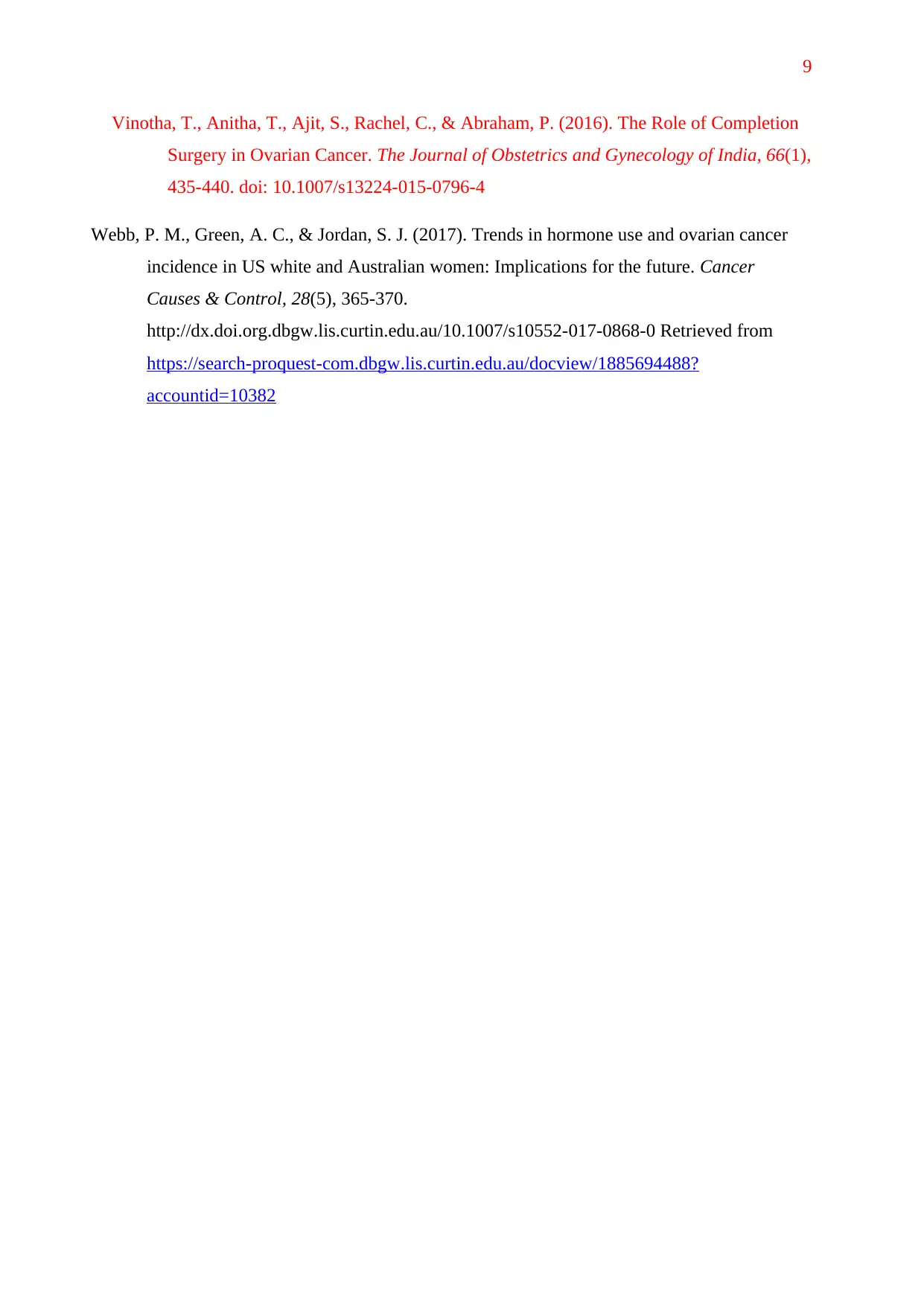
9
Vinotha, T., Anitha, T., Ajit, S., Rachel, C., & Abraham, P. (2016). The Role of Completion
Surgery in Ovarian Cancer. The Journal of Obstetrics and Gynecology of India, 66(1),
435-440. doi: 10.1007/s13224-015-0796-4
Webb, P. M., Green, A. C., & Jordan, S. J. (2017). Trends in hormone use and ovarian cancer
incidence in US white and Australian women: Implications for the future. Cancer
Causes & Control, 28(5), 365-370.
http://dx.doi.org.dbgw.lis.curtin.edu.au/10.1007/s10552-017-0868-0 Retrieved from
https://search-proquest-com.dbgw.lis.curtin.edu.au/docview/1885694488?
accountid=10382
Vinotha, T., Anitha, T., Ajit, S., Rachel, C., & Abraham, P. (2016). The Role of Completion
Surgery in Ovarian Cancer. The Journal of Obstetrics and Gynecology of India, 66(1),
435-440. doi: 10.1007/s13224-015-0796-4
Webb, P. M., Green, A. C., & Jordan, S. J. (2017). Trends in hormone use and ovarian cancer
incidence in US white and Australian women: Implications for the future. Cancer
Causes & Control, 28(5), 365-370.
http://dx.doi.org.dbgw.lis.curtin.edu.au/10.1007/s10552-017-0868-0 Retrieved from
https://search-proquest-com.dbgw.lis.curtin.edu.au/docview/1885694488?
accountid=10382
1 out of 11
Your All-in-One AI-Powered Toolkit for Academic Success.
+13062052269
info@desklib.com
Available 24*7 on WhatsApp / Email
![[object Object]](/_next/static/media/star-bottom.7253800d.svg)
Unlock your academic potential
© 2024 | Zucol Services PVT LTD | All rights reserved.